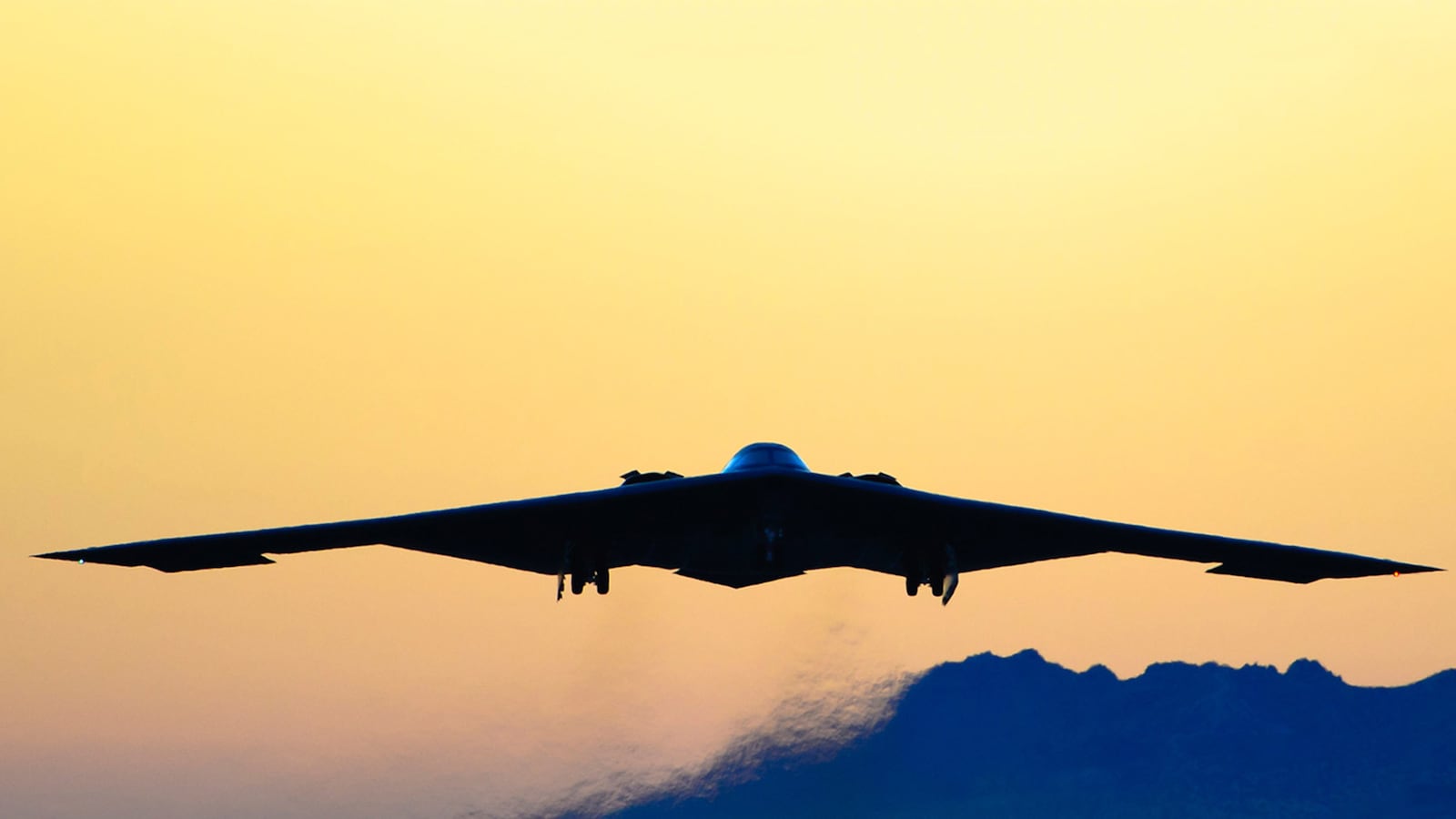The Pentagon is doubling down on the development of a new arsenal of stealth fighters, bombers, and drones in its newly unveiled budget for next year.
Never mind the “fifth generation” stealth jets currently rolling off defense contractor assembly lines. The Pentagon is starting to pour money into three different projects to research and develop “sixth-generation” stealth fighters, plus funding for a new Air Force stealth bomber and new Navy carrier-based stealth drone.
Together, the efforts represent a whole new invisible air force, potentially. Oh, and the Pentagon wants a bunch of laser weapons and rail guns, too.
The budget, released Monday, includes a new project that the Pentagon calls the Aerospace Innovation Initiative. The new program—which is going to be led by the Pentagon’s premier research arm, the Defense Advanced Research Projects Agency—seeks to build a new prototype stealth fighter—an “X-plane.” The new jet would be a prototype to show off new technologies that could be used to help develop a new advanced stealth fighter for the Air Force and Navy.
The prototype would be a precursor to a “sixth-generation” successor to the Air Force’s F-22 Raptor air-superiority fighter. It would also be the basis for a replacement for the Navy’s “fourth-generation” F/A-18E/F Super Hornet.
In addition to money to build the new prototype jet, the proposed budget also includes cash for the Navy and Air Force’s own internal fighter programs to replace the F/A-18 and F-22. That makes total of three next-generation fighter programs.
The budget documentation is vague—but it suggests that the new DARPA prototype program is aimed at developing technology to defeat enemies like Russia or China. Top defense officials—particularly in the Navy—have expressed concerns that current stealth fighters like the F-22 Raptor and F-35 are not going to be able to survive against the advanced air defenses that Russia and China are working on. That’s mostly because new types of low-frequency radars will be able to detect, track, and attack those jets.
That’s why the DARPA initiative will “advanc[e] key enabling technologies for future systems operation in denied and contested environments,” as the budget document reads.
In his testimony before Congress last week, Frank Kendall, the Pentagon’s chief weapons buyer, offered a little more detail. He said that the Defense Department would start developing a new “X-plane” to help keep U.S. industry ahead of competitors and make sure the Air Force and Navy have an aircraft that can control the skies now that the $400 billion F-35 project is nearly through its two-decade design phase.
“The pending budget submission will include an Aerospace Innovation Initiative, a new DARPA-led program in partnership with the Navy and Air Force intended to develop the technologies and address the risks associated with the air-dominance platforms that will follow the F-35, as well as other advanced aeronautical challenges,” Kendall told the House Armed Services Committee on Jan. 28.
But the new prototype fighter is part of an even larger Pentagon effort called the Defense Innovation Initiative to boost its technological lead over foreign powers like Russia and China. According to a Pentagon statement released on Feb. 2, Kendall’s plan includes new high-speed strike weapons, rail guns, and lasers among other technologies.
Details are hard to come by—there is barely any mention of the exactly what the Defense Department plans to do in any of the documents the Pentagon released. The Navy budget includes $67 million for the rail guns and lasers while the Air Force budget includes $14 million for laser weapons—but there is little or no detail about what they hope to accomplish.
Examining the budget more closely, there is no specific program called the Aerospace Innovation Initiative in there. Instead, the prototype X-plane effort seems to be included as part of DARPA’s $2.9 billion budget. There are some references to “advanced aerospace systems” including one line that would call for $185 million in research money. There are also some vague references in the Air Force’s budget that might refer to the new prototype program—the service has over $2.7 billion budgeted for advanced technology developments and prototypes.
Meanwhile, the proposed budget also separately includes $5 million for a Navy “Next Generation Fighter”—which was previously known as the F/A-XX program. The F/A-XX is a Navy effort to replace its workhorse Super Hornet fighters by the mid-2030s.
The Air Force too has money for a new fighter squirreled away in the budget. It includes $8.8 million for a program called Next Generation Air Dominance—which is also known as F-X within the Air Force. That program is intended to replace the F-22 and an older jet called the F-15C Eagle, which is designed to kill other jets, but is well over 30 years old.
The Navy and Air Force have learned from the $400 billion F-35 program, which tried to force the two services to share a single, unwieldy fighter jet family. Navy and Air Force officials have both said they want to develop two separate planes that share common technology. What they don’t want is to develop the same plane and end up with another F-35-style financial and technological disaster. Presumably, these previously announced efforts are separate for Kendall’s plan for a new X-plane—but that is not entirely clear at this point.
Meanwhile, the Air Force is continuing on its quest to develop a new super stealth bomber for $550 million each that would be flying by the mid-2020s. The Air Force won’t say much about the new bomber except that it will be extremely stealthy, subsonic, and that it will be nuclear-capable in time—and it will be armed with a new Long-Range Stand-Off cruise missile. The Air Force wants between 80 and 100 new bombers.
The bomber program is slated to receive $1.2 billion in the 2016 budget proposal. Either Northrop Grumman or a Boeing/Lockheed Martin team will win the contract to build the new bomber—which is going to be worth at least $50 billion in research and development—later this year. Either way, it’s going to be expensive.
Not to be left out, the Navy is continuing to work a stealthy new drone called the Unmanned Carrier Launched Airborne Surveillance and Strike aircraft. But no one is quite happy with the current specifications for the new jet. As such, the Pentagon is reviewing the requirements for the new drone—which have been a point of contention.
The Navy has been forced to push back the program from 2020 to 2023, but the service is still going to shell out $135 million in development money this year for the new robotic jet. It’s just a small piece of a much larger reboot of America’s fighting forces in the sky.






